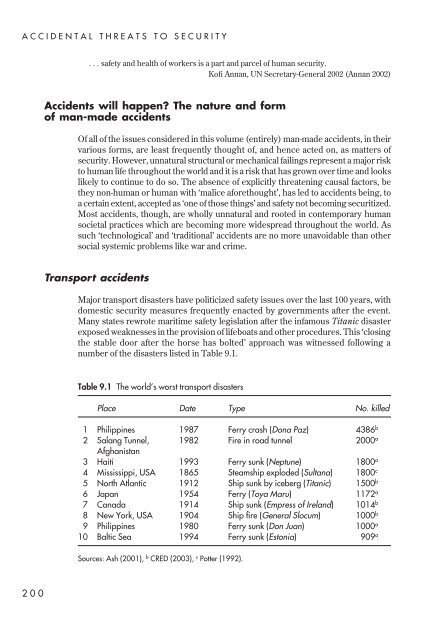Understanding global security - Peter Hough
Understanding global security - Peter Hough
Understanding global security - Peter Hough
Create successful ePaper yourself
Turn your PDF publications into a flip-book with our unique Google optimized e-Paper software.
ACCIDENTAL THREATS TO SECURITY<br />
. . . safety and health of workers is a part and parcel of human <strong>security</strong>.<br />
Kofi Annan, UN Secretary-General 2002 (Annan 2002)<br />
Accidents will happen? The nature and form<br />
of man-made accidents<br />
Of all of the issues considered in this volume (entirely) man-made accidents, in their<br />
various forms, are least frequently thought of, and hence acted on, as matters of<br />
<strong>security</strong>. However, unnatural structural or mechanical failings represent a major risk<br />
to human life throughout the world and it is a risk that has grown over time and looks<br />
likely to continue to do so. The absence of explicitly threatening causal factors, be<br />
they non-human or human with ‘malice aforethought’, has led to accidents being, to<br />
a certain extent, accepted as ‘one of those things’ and safety not becoming securitized.<br />
Most accidents, though, are wholly unnatural and rooted in contemporary human<br />
societal practices which are becoming more widespread throughout the world. As<br />
such ‘technological’ and ‘traditional’ accidents are no more unavoidable than other<br />
social systemic problems like war and crime.<br />
Transport accidents<br />
Major transport disasters have politicized safety issues over the last 100 years, with<br />
domestic <strong>security</strong> measures frequently enacted by governments after the event.<br />
Many states rewrote maritime safety legislation after the infamous Titanic disaster<br />
exposed weaknesses in the provision of lifeboats and other procedures. This ‘closing<br />
the stable door after the horse has bolted’ approach was witnessed following a<br />
number of the disasters listed in Table 9.1.<br />
Table 9.1 The world’s worst transport disasters<br />
Place Date Type No. killed<br />
1 Philippines 1987 Ferry crash (Dona Paz) 4386 b<br />
2 Salang Tunnel, 1982 Fire in road tunnel 2000 a<br />
Afghanistan<br />
3 Haiti 1993 Ferry sunk (Neptune) 1800 a<br />
4 Mississippi, USA 1865 Steamship exploded (Sultana) 1800 c<br />
5 North Atlantic 1912 Ship sunk by iceberg (Titanic) 1500 b<br />
6 Japan 1954 Ferry (Toya Maru) 1172 a<br />
7 Canada 1914 Ship sunk (Empress of Ireland) 1014 b<br />
8 New York, USA 1904 Ship fire (General Slocum) 1000 b<br />
9 Philippines 1980 Ferry sunk (Don Juan) 1000 a<br />
10 Baltic Sea 1994 Ferry sunk (Estonia) 909 a<br />
Sources: Ash (2001), b CRED (2003), c Potter (1992).<br />
200
















